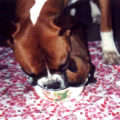Nutrition – Stages in the Synthesis of Polyunsaturated Fatty Acids of the Omega 6 Series
Stages in the Synthesis of Polyunsaturated Fatty Acids of the Omega 6 Series
Linoleic acid (18: 2)
Gamma-linolenic acid or GLA (18: 3)
Dihomo-gamma-linolenic acid or DHLA (20: 3)
Arachidonic acid (20: 4)
Very-long-chain fatty acids (22 carbon atoms)
(X: Y): X indicates the number of carbon atoms in the molecule
Y indicates the number of double bonds in the molecule.
Each stage in the transformation calls for a specific enzyme, and differences can be noted between dogs and cats. In cats, the change from linoleic acid to gamma-linolenic acid (or GLA) is a delicate stage: for the enzyme responsible for this first unsaturation has a very low level of activity. This deficiency is one of the reasons why the cat is unable to make arachidonic acid from linoleic acid himself.
Moreover, in mature animals, the efficiency of this enzyme appears to decrease with age, which would result in a reduction in GLA synthesis. Certain diseases such as hepatic disorders, diabetes or hypothyroidism, are other possible causes of disruption in the synthesis of polyunsaturated fatty acids.
Providing gamma-linolenic acid (or GLA) therefore proves worthwhile each time that a poor transformation of linoleic acid into gamma-linolenic acid is being suspected. The cat reacts especially well to the addition of GLA to his diet on account of the previously mentioned enzymatic deficiency.
Sources Of Gamma-Linolenic Acid
Most vegetable oils (sunflower, corn, wheatgerm, grapeseed, soybean…) are very rich in linoleic acid. But the only oils providing an attractive quantity of GLA are: borage, evening primrose and blackcurrant seed oils. Among these, borage oil is the one with the highest GLA content.
Comparison of GLA content between different vegetable oils
Borage (Borago officinalis) , is a plant native from Asia, but also cultivated in North Africa and in different countries of Europe, including France, England, Germany and the Netherlands. The oil is obtained by pressing the seeds.
Physiological Consequences of GLA Supplementation
– Enriching the food with gamma-linolenic acid promotes the incorporation of this acid into tissues: in the liver, red corpuscles, vessel walls... The efficiency of this incorporation into cell membranes is quite superior to the one obtained from the transformation of linoleic acid. Thanks to AGPIs, cell membranes keep their fluidity, an essential quality for vital exchanges between cells to take place. Therefore the GLA food intake prevents the risk of deficiency in high-risk animals: mature animals or those suffering from enzymatic deficiencies.
– GLA supplementation is especially relevant in another respect: it promotes an increase in the production of hormones whose anti-inflammatory effects are well-known, type 1 prostaglandins. This production takes place at the expense of the synthesis of other prostaglandins, type 2 prostaglandins, which, for their part, encourage signs of inflammation.


